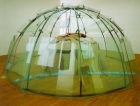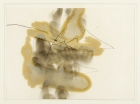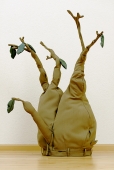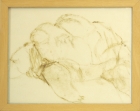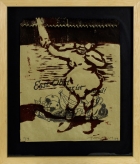
Artist | Mario Merz (1925 - 2003)
https://www.artist-info.com/artist/Mario-Merz
Biography
Biography
born 1925 in Milano
About the work (english / deutsch) At the still point of the turning world
About the work (english / deutsch) At the still point of the turning world
"Mario Merz paints a picture" could be the title of this accompanying text. First of all, he lays the glass around the top part of the dome, then he concentrates totally on the inside igloo which is covered with slabs made form local sandstone. It becomes clear how painterly his gestures are: as if he were applying brushstrokes, some transparent and others opaque. And suddenly we remember that Mario Merz worked as a painter at the end of the 1950's/ beginning of the 1960's.
He had asked us to acquire sandstone slabs that were irregular, sawn into shape rather than broken. He secured them, took them down, broke them on the spot. Bit by bit, the shell began to spread, without ever becoming a form of armour, loosely, as if through a movement of the hand. Sometimes he thought that this or that part was too "aggressive", he allowed ajoining together of the "rational with the irrational", he allowed the dark light to shine through at certain points, at other points he doubled the layers, constantly concerned with leaving room for a kind of organic movement, formally as well as in terms of colour. Under no circumstances was the igloo to be walled up or appear impaired with regard to its basic form. It had to breath, relativize its colossal weight as a natural appearance. When he had completed the inner igloo, he began with the "glazing" of the lower half of the outside. He had asked for crystal glass, which ranged from almost square forms to narrow rectangular pieces. On the day of installation, he chose more glass, this time he also specifically chose broken glass. Again here, the procedure was the same: as if the aim was to paint a sky, sunlight breaking through, fragmented, diffuse, scattered, clear light. A bell jar of light over an immense horizon. That was the first day.
The next day, he placed the sentence from T.S. Eliot's "Four Quartets " (1935) "At the still point of the turning world" in neon letters at ground level, on to glass and stone. The letters form a hemicycle which, starting from the outer igloo, runs into contact with the inner one and then runs into the outer one again.
Many discussions were hold and locations viewed before this igloo became reality. In one of these discussions, the gist of what Mario Merz said was that he was fed up with talking about the significance of the igloo and the Fibonacci sequence - that mathematical sequ@nce which he has used again and again as a metaphorfor poetic acceleration (1-1-2-3-5-8-13-21 ... ). I can understand Mario Merz because he is so often nailed down to the form alone, as if this was all that existed and not the various ways of achieving its creation. The secret of the similar and the different is imprinted in life. The igloo is a prototype in so far as it shows a self-supporting construction and the three-dimensional model of an opening spiral shape that embodies a dynamic principle, of which the acceleration of the Fibonacci sequence is the correlate.
The poetic model which Mario Merz developed for a cosmic, organic, sociodynamic, ecological idea at the end of the 1960's bears reference to itself and the creative method. It contains the "still point" as a form of consciousness through which realisation becomes at all possible. This "still point" describes a paradox because it has to pin down, in qualitative terms, this - its own - stillness in order to locate the position of those movements in or stemming from the movement which turn the artist into a seismograph. In this respect, the igloo is a form which forgets itself. It radiates from the gestures, the materials, the colours, which allow a constant renewal of its origination.
The neon trail is like a river that flows by. If you look from the window on to the igloo, you see how the words in their reflection join to form a new circle and how they loose themselves in the room in fans of light which are refracted in a variety of, ways.
I wanted a work by Mario Merz for Frankfurt. On the one hand, because it was to be, in accordance with the idea of the "Georg and Franziska Speyer'sche Hochschulstiftung", dedicated to the work spanning twenty years of the former head of the department of culture, Hilmar Hoffmann, and an the other hand, because a museums first and foremost connection is to its location.
At the still point of the turning world is an exact reflection of the question which Mario Merz asked in another work in 1977. "Noi giriamo intorno alle case o le case girano intorno a noi?" (Do we circle around the houses or do the houses circle around us?) A question which we can ask ourselves with particular urgency in Frankfurt.
At the still point of the turning world
"Mario Merz malt ein Bild" könnte der Titel dieses Begleittextes sein. Zuerst legte er das Glas um den oberen Teil der Kuppel, dann widmete er sich ganz dem mit örtlichen Sandsteinplatten bedeckten inneren Iglu. Deutlich wird, wie malerisch seine Gesten sind: als würde er Pinselstriche setzen, die einen transparent, die anderen opak. Und plötzlich erinnert man sich, daß Mario Merz Ende der fünziger / Anfang der sechziger Jahre als Maler tätig war.
Er hatte uns gebeten, Sandsteinplatten in unregelmäßiger, gesägter, nicht zerbrochener Form zu besorgen. Er brachte sie an, nahm sie weg, sie wurden vor Ort gebrochen. Stück für Stück breitete sich die Hülle aus, ohne je ein Panzer zu werden, locker, wie aus einer Handbewegung heraus. Manchmal meinte er, daß diese oder jene Stelle zu "aggressiv" sei, ließ das "Rationale mit dem Irrationalen" eine Verbindung eingehen, ließ mancherorts das dunkle Licht durchscheinen, an anderen Stellen verdoppelte er die Schichten, stets darauf bedacht, eine Art von organischer Bewegung offen zu halten, formal wie farblich. Unter keinen Umständen durfte der Iglu zugemauert oder in seiner Grundform beeinträchtigt erscheinen. Er mußte atmen, sein enormes Gewicht als selbstverständliche Erscheinung relativieren. Als er den inneren Iglu beendet hatte, begann er mit der "Verglasung" der unteren Hälfte des äußeren. Er hatte sich Kristallglas erbeten, das von fast quadratischen Formen bis zu schmalen Rechteckflächen reichte. Am Tag der Installation suchte er sich weiteres Glas aus, diesmal gezielt auch Bruchglas. Auch hier, dasselbe Vorgehen: Als ginge es darum, einen Himmel zu malen, durchbrechendes Sonnenlicht, splittemdes, diffuses, streuendes, klares Licht. Eine Lichtglocke über einem immensen Horizont. Das war der erste Tag.
Am nächsten Tag legte er in Neonbuchstaben den Satz aus T.S. Eilots "Vier Quartette" (1935) „At the still point of the turning world“ ebenerdig auf Glas und Stein. Die Buchstaben beschreiben einen Halbbogen, der vom äußeren Iglu ausgehend tangential den inneren berührt und wieder an den äußeren stößt.
Es hat viele Gespräche und Ortsbesichtigungen gegeben, bevor dieser Iglu Realität wurde. In einem dieser Gespräche sagte Mario Merz sinngemäß, er hätte es satt, über die Bedeutung des Iglu und die Fibonacci-Reihe zu sprechen. Jene mathematische Reihe, die er immer wieder als Metapher einer poetischen Beschleunigung verwendet (1-1-2-3-58-13-21 ... ). Ich verstehe Mario Merz, weil er so oft einzig auf die Form festgenagelt wird, als gäbe es nur diese und nicht den vielfältigen Weg, der sie entstehen läßt. Das Geheimnis des Ähnlichen und Verschiedenen ist dem Leben eingeschrieben. Der Iglu ist ein Prototyp, insofern als er eine selbsttragende Konstruktion und das räumliche Modell einer sich öffnenden Spiralform darstellt, ein dynamisches Prinzip verkörpernd, dessen Korrelat die Beschleunigung der in der Natur verankerten Fibonacci-Reihe ist.
Das poetische Modell, das Mario Merz für eine kosmische, organische, gesellschaftsdynamische, ökologische, auf sich selbst und die schöpferische Methode bezogene Vorstellung gegen Ende der sechziger Jahre entwickelt hat, enthält den "still point" als eine Bewußtseinsform, die Erkenntnis überhaupt erst ermöglicht. Dieser "ruhende Punkt" beschreibt ein Paradox, weil er qualitativ jene ihm eigene Ruhe verfestigen muß, um in oder aus der Bewegung heraus jene Bewegungen zu orten, die den Künstler zum Seismographen machen. Insofern ist der Iglu eine Form, die sich selbst vergißt. Sie leuchtet aus den Gesten, den Materialien, den Farben, die sie stets von neuem entstehen läßt.
Die Neonspur ist wie ein Fluß, der vorüberzieht. Blickt man vom Fenster auf den Iglu, sieht man, wie sich die Worte spiegelnd zu einem neuen Kreis schließen, sich wie Lichtfächer in vielfacher Brechung im Raum verlieren.
Ich hatte mir von Mario Merz eine Arbeit für Frankfurt gewünscht. Zum einen, weil sie gemäß der Vorstellung der "Georg und Franziska Speyer'sche Hochschulstiftung" der 20jährigen Arbeit des früheren Kulturdezernenten Hilmar Hoffmann gewidmet sein sollte, zum anderen, weil ein Museum immer zuerst an seinen Ort gebunden ist. At the still point of the turning world (Am ruhenden Punkt der sich drehenden Welt) reflektiert genau jene Frage, die Mario Merz 1977 in einer anderen Arbeit stellte: "Noi giriamo intorno alle case o le case girano intorno a noi?" (Kreisen wir um die Häuser oder kreisen die Häuser um uns?) Eine Frage, die man sich gerade in Frankfurt besonders eindringlich stellen kann.
German text by Jean-Christophe Ammann/ Translation by Jennifer Greitschus
(Extract - Full printed version available in the Museum)
MMK - Museum für Moderne Kunst, Frankfurt am Main
 offers / Requests offers / Requests  |
About this service |
|---|
 Exhibition Announcements Exhibition Announcements  |
About this service |
|---|
 Visualization |
Learn more about this service | ||
|---|---|---|---|

Interested in discovering more of this artist's networks?
3 easy steps: Register, buy a package for a visualization, select the artist.
See examples how visualization looks like for an artist, a curator, or an exhibition place: Gallery, museum, non-profit place, or collector.

Exhibition History

|
SUMMARY based on artist-info records. More details and Visualizing Art Networks on demand. Venue types: Gallery / Museum / Non-Profit / Collector |
||||||||||||
| Exhibitions in artist-info | 240 (S 41/ G 199) |
Did show together with - Top 5 of 3630 artists (no. of shows) - all shows - Top 100
|
||||||||||
| Exhibitions by type | 240: 51 / 101 / 84 / 4 | |||||||||||
| Venues by type | 168: 42 / 64 / 58 / 4 | |||||||||||
| Curators | 124 | |||||||||||
| artist-info records | Jan 1968 - Jun 2022 | |||||||||||
|
Countries - Top 5 of 17 Germany (63) Italy (37) United States (31) Switzerland (25) France (24) |
Cities - Top 5 of 83 New York (22) Berlin (12) Frankfurt am Main (11) Villeurbanne (10) Zürich (9) |
Venues (no. of shows )
Top 5 of 168
|
||||||||||
Curators (no. of shows)
Top 5 of 124
|
| Museo d'arte della Svizzera italiana Lugano - MASI | G | Mar 2022 - Jun 2022 | Lugano | (11) | +0 | |
| DZ BANK [KUNSTSAMMLUNG] | G | May 2018 - Oct 2018 | Frankfurt am Main | (36) | +0 | |
| Leber, Christina (Curator) | +0 | |||||
| Galerie C | G | May 2017 - Jun 2017 | Neuchâtel | (4) | +0 | |
| Centro per l'Arte Contemporanea Luigi Pecci | G | Apr 2017 - Jan 2018 | Prato | (9) | +0 | |
| Pezzato, Stefano (Curator) | +0 | |||||
| Centre Pompidou - Metz | G | Mar 2017 - Aug 2017 | Metz | (27) | +0 | |
| Lavigne, Emma (Curator) | +0 | |||||
| Meisel, Hélène (Curator) | +0 | |||||
| Konrad Fischer | G | Jun 2016 - Jul 2016 | Düsseldorf | (27) | +0 | |
| Werd, Guido de (Curator) | +0 | |||||
| Keep reading |











